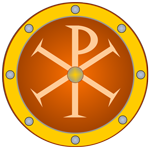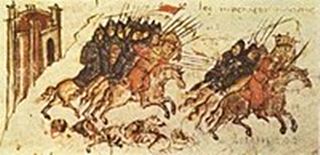
Battle of Versinikia |
year: 81322 June 813 |
| A major defeat by the Bulgarians in an ambitious campaign | ★ ★ ★ ★ ★ |
|
enemy: Bulgarians
|
location: Near the castle of Versinikia. The exact location is unknown. It was somewhere in SE Bulgaria, between Malamirovo and Edirne (Turkey)
|
accuracy:
●●●●●
|
|
battle type: Pitched Battle |
war: Early Bulgarian Wars |
modern country:
Bulgaria |
| ▼ The Byzantines(emperor: Michael I Rangabe) | ▼ The Enemies | |
| Commander: | Emperor Michael Ι | Khan Krum |
| Forces: | 20.000 - 30,000 | 12,000 (max) |
| Losses: | 2,000 - 3,000 |
| Background story: |
| After the disastrous battle of Pliska in 811, the Byzantine Empire was in a really difficult situation. The Bulgarians started again to attack in Thrace next year. Many towns were seized and their population was sent far to the north, across the Danube. The raids created such panic among the Byzantine population that several towns were emptied even without being attacked. In the autumn of 812, after failed peace negotiations, the Bulgars besieged Mesembria (modern Nessebar). They had new, state-of-the-art siege machines built by an Arab engineer and captured the town easily. During the winter of 812 - 813 Khan Krum started intense preparations for an attack against Byzantium, while Emperor Michael I was preparing for defense. In February 813, Bulgarian forces made several reconnaissance raids in Eastern Thrace but were pushed back. The retreat was considered as a God-sent victory and encouraged a counter-attack. The Byzantines gathered again a large army from all themes of their Empire including the guards of the Syrian passes. The departure of the army was a celebration and the population of the city accompanied the troops outside the city wall. The army marched to the north but did not take any actions to take back Mesembria. They encamped in the vicinity of Adrianople where the army looted and robbed its own country. Khan Krum also headed to Adrianople. |
The Battle: |
 Battle of Versinikia (Manasses chronicle) The emperor Μichael I Rangabe was in the center of the Byzantine formation, together with Leo the Armenian . The left flank was led by Leo Vardas and on the right was general Ioannis Aplakis with 8,000 men from Macedonia and Thrace. The battle was short: Ioannis Aplakis attacked from the right (probably on his own initiative) and at first pushed back the left wing of the Bulgarians. But the rest of the Byzantine army remained inactive without engaging in battle. When Kroumos saw this, he moved a force of Slavic infantry to strengthen his left side, and at the same time outflanked the attacking Byzantines with his heavy cavalry. Alpakis' contingent was surrounded and. without support from the others, was soon overcome; Alpakis was killed. Then the whole Byzantine army began to retreat. The Anatolian battalions in the center were the first to retreat and were followed by all the others. The chief commanders of Byzantine army, including the Emperor Michael Rangabe and Leo the Armenian, were the first to abandon the battlefield. When the Bulgarians saw the enemy to retreat without obvious reason, they at first suspected a trap. They did not expect to win so easily and at first did not chase them. But when they confirmed that the enemy was fleeing in panic, their cavalry rushed after the Byzantines. The Bulgarians took the Byzantine camp and a rich prize including gold and weaponry. It is generally believed that one of the generals, Leo the Armenian, was primarily responsible for the defeat, ordering the retreat of the units that were still not engaged in the battle. It is almost certain that Leo undermined Rangabe, in order to weaken him and to be able to take his throne. If this was really his plan, he succeeded perfectly. |
Noteworthy: |
| After capturing Mesembria, the Bulgarians found there 36 copper siphons used to throw the famous Greek fire (which was the top-secret weapon of the Byzantines) |
Aftermath: |
| Versinikia worsened the grim situation of Byzantium and sealed the fate of Michael I Rangabe who was forced to abdicate. He was replaced by Leo the Armenian/ On 17 July 813 Krum reached the walls of Constantinople but he was not well prepared to take it. |
|
|
